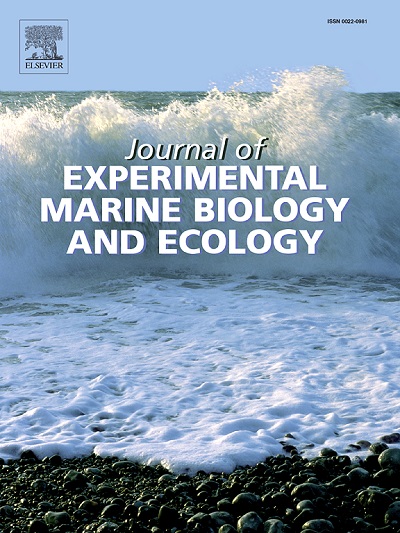Captive rearing reduces the sensitivity of Acartia tonsa copepods to predator cues
IF 1.8
3区 生物学
Q3 ECOLOGY
Journal of Experimental Marine Biology and Ecology
Pub Date : 2025-02-18
DOI:10.1016/j.jembe.2025.152091
引用次数: 0
Abstract
Captive populations are often subject to different selective pressures than their wild counterparts, which could result in trait differences between these populations. This study investigates the effect of captive rearing on the swimming behavior and escape responses of Acartia tonsa, a species of marine copepod zooplankton that use hydromechanical signal detection to aid in finding food, locating mates, and avoiding predation. As captive populations of A. tonsa experience reduced interspecific predation and higher population densities compared to wild populations, it was hypothesized that these differences may drive adaptive evolution of swimming behavior in this species. Several components of routine swimming were compared (swimming speed, number of hops, distance of hops, frequency of hops) for groups of captive-reared and wild-caught A. tonsa, revealing that wild-caught copepods swim faster and hop more frequently than captive-reared copepods. However, when the escape responses of the captive-reared and wild-caught populations were compared using an artificial predator mimic, no significant differences were found in the number of sequential hops performed during the escape response, the maximum velocity of the response, or the total distance traveled during the response. Although the escape responses performed by the captive-reared and wild-caught copepods were similar, the captive-reared individuals often showed no response to the artificial predator mimic (34 % of individuals responded to the predator mimic), whereas wild individuals almost always showed a response (96 % responded). This suggests that captive rearing may have resulted in reduced sensitivity to hydromechanical signals in captive copepods compared to wild copepods, as responding to these signals in a predator-free captive environment would impose an unnecessary energy cost. This study offers new insight into how captive-rearing may impact copepod populations and provides evidence of how predator-driven evolution and density dependent selection may influence the behavior of copepod species.
求助全文
约1分钟内获得全文
求助全文
来源期刊
CiteScore
4.30
自引率
0.00%
发文量
98
审稿时长
14 weeks
期刊介绍:
The Journal of Experimental Marine Biology and Ecology provides a forum for experimental ecological research on marine organisms in relation to their environment. Topic areas include studies that focus on biochemistry, physiology, behavior, genetics, and ecological theory. The main emphasis of the Journal lies in hypothesis driven experimental work, both from the laboratory and the field. Natural experiments or descriptive studies that elucidate fundamental ecological processes are welcome. Submissions should have a broad ecological framework beyond the specific study organism or geographic region.
Short communications that highlight emerging issues and exciting discoveries within five printed pages will receive a rapid turnaround. Papers describing important new analytical, computational, experimental and theoretical techniques and methods are encouraged and will be highlighted as Methodological Advances. We welcome proposals for Review Papers synthesizing a specific field within marine ecology. Finally, the journal aims to publish Special Issues at regular intervals synthesizing a particular field of marine science. All printed papers undergo a peer review process before being accepted and will receive a first decision within three months.

 求助内容:
求助内容: 应助结果提醒方式:
应助结果提醒方式:


